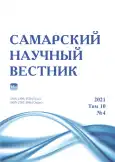Ecological and biological features of Rosa glauca Pourr., Rosa canina L., Rosa majalis Herrm. in using as rootstocks of garden roses in the forest-steppe of Western Siberia
- Authors: Kozlova M.V.1
-
Affiliations:
- Central Siberian Botanical Garden of Siberian Branch of Russian Academy of Sciences
- Issue: Vol 10, No 4 (2021)
- Pages: 61-67
- Section: General Biology
- URL: https://journals.rcsi.science/2309-4370/article/view/104896
- DOI: https://doi.org/10.17816/snv2021104109
- ID: 104896
Cite item
Full Text
Abstract
The paper presents the results of a comprehensive comparative study of Rosa glauca Pourr and Rosa canina L. – rose hips used as rootstocks of garden roses – in a continental climate. A representative of the local flora Rosa majalis Herrm served as a model object for studying seasonal rhythmics, winter hardiness, as well as histochemical features. Based on studies of the objects ecological morphology, the nature of damage to aboveground shoot systems during wintering is described, the determining role of the minimum air temperature in assessing the adaptive potential of plants is noted. Differences in the seasonal dynamics of starch in the tissues of shoots of three species are most characteristic in the pre-winter period: as for R. glauca, the average amount of starch is observed in the perimedular zone while the low one is in single-row core rays. As for R. canina, a low amount of starch is observed in the perimedular zone and in single cells of single-row core rays. As for a representative of the local flora of R. majalis, almost complete starch hydrolysis occurs; it was recorded only in single cells of the perimedular zone. The paper also contains the results of joint research with the Nikitsky Botanical Garden, including X-ray examination of seeds and expedition studies to increase the collection gene pool of wild rose rootstocks.
Keywords
Full Text
##article.viewOnOriginalSite##About the authors
Margarita Viktorovna Kozlova
Central Siberian Botanical Garden of Siberian Branch of Russian Academy of Sciences
Author for correspondence.
Email: margaretta23@inbox.ru
engineer-researcher of Ornamental Plants Introduction Laboratory
Russian Federation, NovosibirskReferences
- Сатлейкина И.А. Влияние размера семян на качество сеянцев розы щитконосной // Состояние и проблемы садоводства России. Ч. II. Новосибирск: СО РАСХН, 1997. С. 229–230.
- Пашина М.В. Анатомо-гистохимические особенности роз при интродукции в лесостепном Прииртышье: автореф. дис. … канд. биол. наук. Омск, 2003. 16 с.
- Шагапов Р.Ш., Шагапов Р.Р. Подвои шиповника для культурных роз в Приуралье // Известия Оренбургского государственного аграрного университета. 2016. № 2 (58). С. 144–145.
- Vasilyeva O.Yu., Ambros E.V., Novikova T.I. Ontomorphogenesis of axillary meristem-derived micropropagated plants of Rosa canina rootstock // Acta Horticulturae. 2021. Vol. 1324. P. 143–150. doi: 10.17660/ActaHortic.2021.1324.22.
- Штанько И.И. Важнейшие вопросы размножения и выращивания саженцев роз // Опыт выращивания роз. М.: Колос, 1965. С. 41–57.
- Васильева О.Ю. Биологические особенности видов рода Rosa L., интродуцируемых в качестве подвоев в Западной Сибири: дис. … д-ра биол. наук: 03.00.05. Новосибирск, 2002. 441 с.
- Коробов В.И., Бударин А.А. Клоновые подвои для садовых роз на Черноморском побережье России // Субтропическое и декоративное садоводство. 2009. № 42–1. С. 83–88.
- Васильева О.Ю. Онтоморфологические особенности семенных и клоновых подвоев садовых роз в условиях Сибири // Сибирский вестник сельскохозяйственной науки. 2008. № 1. С. 52–59.
- Бузунова И.О. Роза, шиповник – Rosa L. // Флора Восточной Европы. Т. 10. СПб., 2001. С. 329–361.
- Хапугин А.А. О нахождении Rosa glauca Pourr. (Rosaceae) в Республике Мордовия // Российский журнал биологических инвазий. 2011. Т. 4, № 4. С. 84–87.
- Агроклиматические ресурсы Новосибирской области. Л.: Гидрометеоиздат, 1976. 155 с.
- Центральный сибирский ботанический сад (справочник-путеводитель) / сост. И.В. Таран, А.А. Храмов. Новосибирск: Наука, 1981. 76 с.
- Онтогенетический атлас лекарственных растений. Йошкар-Ола: МарГУ, 1997. 240 с.
- Онтогенетический атлас растений. Т. 5. Йошкар-Ола: МарГУ, 2007. 372 с.
- Фурст Г.Г. Методы анатомо-гистохимического исследования растительных тканей. М., 1979. 155 с.
- Щербакова М.А. Определение качества семян рентгенографическим методом // Плодоношение кедра сибирского в Восточной Сибири: тр. Института леса и древесины. Т. 62. М., 1963. С. 168–173.
- Смирнова Н.Г. Рентгенографическое изучение семян лиственных древесных растений. М.: Наука, 1978. 243 с.
- Методические указания по семеноведению интродуцентов. М.: Наука, 1980. 63 с.
- Бузунова И.О. Rosa L. – Шиповник, или роза // Флора средней полосы европейской части России. 10-е изд. М.: Товарищество научных изданий КМК, 2006. С. 292–320.
- Юзепчук С.В. Роза (Шиповник) – Rosa L. // Флора СССР. Т. 10. М.; Л., 1941. С. 431–506.
- Сааков С.Г., Риекста Д.А. Розы. Рига: Зинатне, 1973. 359 с.
- Васильева О.Ю., Лезин М.С., Козлова М.В. Онтогенез Prunus pumila L. и Rosa glauca Pourr. в интродукционных популяциях на юге Урала и Западной Сибири // Бюллетень Государственного Никитского ботанического сада. 2019. № 133. С. 86–93. doi: 10.36305/0513-1634-2019-133-86-93.
- Николаева М.Г., Разумова М.В., Гладкова В.Н. Справочник по проращиванию покоящихся семян. Л.: Наука, 1985. 348 с.
- Vasil'eva O.Y. Reproduction systems of representatives of the genus Rosa L. under condition of continental climate // Contemporary Problems of Ecology. 2009. Vol. 2, iss. 4. С. 361–368.
- Козлова М.В., Васильева О.Ю., Юданова С.С. Семенная продуктивность видов семейства Rosaceae, используемых в качестве подвоев в условиях лесостепи Западной Сибири // Вестник КрасГАУ. 2020. № 5. С. 24–30. doi: 10.36718/1819-4036-2020-5-24-30.
Supplementary files












